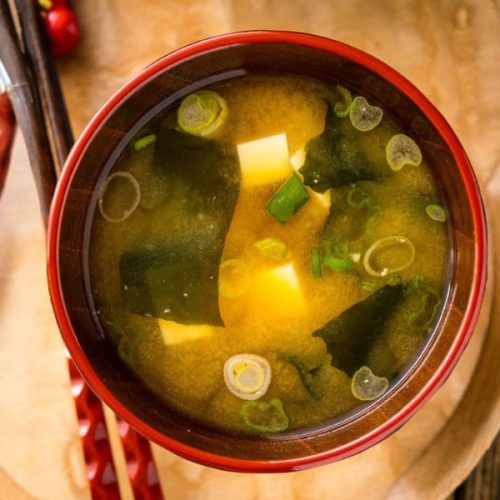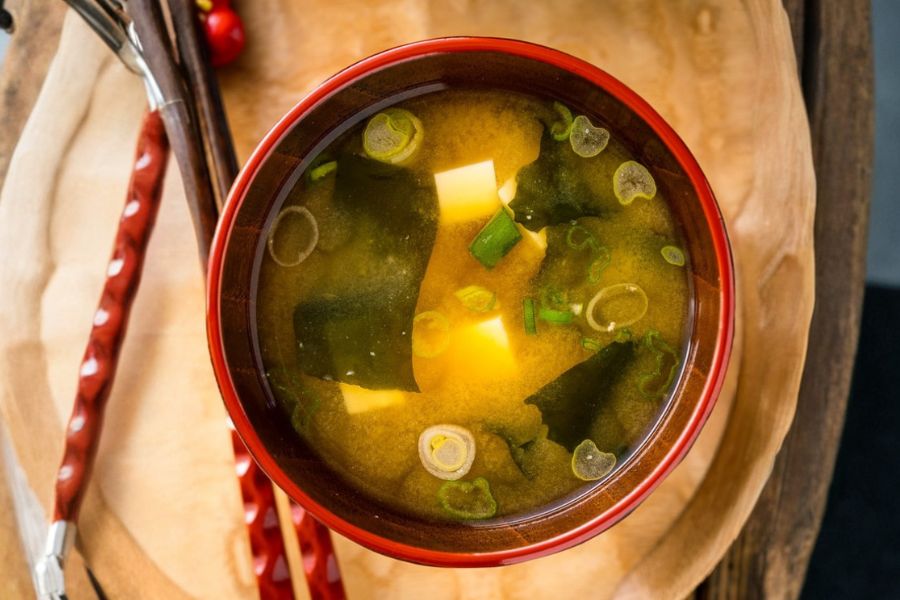This homemade miso soup is a timeless Japanese classic, celebrated for its comforting warmth, umami depth, and simplicity.
The rich, savory flavor comes from a carefully crafted dashi stock, made from kombu seaweed and optional bonito flakes, providing a subtle oceanic essence.
Soft silken tofu adds a plant-based protein boost, while wakame seaweed contributes fiber, minerals, and antioxidants, making this soup both nutritious and satisfying.
Low in saturated fat and naturally gluten-free, it supports heart health and digestion.
Quick to prepare in just 20 minutes, this recipe is ideal for busy weekdays, light lunches, or as a starter for a full meal.

Its simplicity also makes it excellent for meal prep, allowing you to enjoy a nourishing, flavorful soup any day of the week.
Must-Have Tools for Perfect Results
Medium Saucepan
Perfect for gently simmering dashi and miso without boiling, ensuring the delicate umami flavors are preserved. A versatile kitchen staple for soups, sauces, and grains.
Fine-Mesh Strainer
Essential for straining katsuobushi from dashi and dissolving miso evenly. It keeps the soup smooth and clump-free while useful for sifting flour or rinsing grains.
Miso Ladle or Small Bowl
Helps dissolve miso paste gradually into the hot stock, preventing lumps and preserving flavor. Ideal for blending dressings or small batches of sauces.
Sharp Chef’s Knife
Critical for cubing silken tofu neatly and slicing green onions with precision. Its versatility extends to chopping vegetables, herbs, and proteins efficiently.
Cutting Board
Provides a stable, safe surface for preparing tofu, vegetables, and seaweed. Durable boards double as prep stations for a variety of home cooking tasks.

20-Minute Miso Soup
Equipment
- 1 Medium saucepan
- 1 Fine-mesh strainer
- 1 Miso ladle or small bowl
- 1 Sharp chef’s knife
- 1 cutting board
Ingredients
- For the Dashi makes ~4 cups
- 4 cups water
- 1 piece kombu dried kelp, 10 g / 4 x 4 inches
- 1 cup katsuobushi dried bonito flakes, loosely packed
- For the Miso Soup
- 7 oz soft/silken tofu kinugoshi dofu, cubed
- 4 Tbsp miso paste adjust to taste
- 1 Tbsp dried wakame seaweed
- 1 green onion/scallion thinly sliced
Instructions
- Prepare the Kombu Dashi: Begin by placing 4 cups of cold water and a 10-gram piece of kombu (dried kelp) in a medium saucepan. If time allows, soak the kombu for 30 minutes to help release its natural umami. Slowly heat the water over medium-low heat, ensuring it never boils, so the delicate flavors infuse gradually. Just before it reaches a boil, carefully remove the kombu and set it aside to avoid bitterness, leaving behind a clear, mineral-rich Kombu Dashi.
- Enhance with Katsuobushi (Optional): For non-vegetarian dashi, add 1 cup of loosely packed katsuobushi (dried bonito flakes) to the Kombu Dashi and bring the mixture gently to a boil. Reduce heat immediately and let it simmer for 30 seconds to extract a smoky, savory flavor. Turn off the heat and allow the flakes to settle to the bottom for about 10 minutes. Strain the dashi through a fine-mesh sieve to achieve a clear, amber-colored broth known as Awase Dashi.
- Dissolve the Miso Paste: Return the strained dashi to the saucepan and gently warm it over medium heat until it reaches around 205°F (96°C), making sure it does not boil. Place 4 tablespoons of miso paste in a small bowl or ladle, then gradually add a small amount of warm dashi while stirring with chopsticks or a miso muddler until smooth. Slowly incorporate the dissolved miso back into the main pot, ensuring an even distribution without clumps. Adjust the seasoning with additional miso or dashi if desired.
- Add Tofu and Wakame: Cut 7 ounces of silken tofu into ½-inch cubes using a sharp knife on a cutting board to maintain shape. Gently fold the tofu into the miso soup, taking care not to break the delicate cubes. Sprinkle in 1 tablespoon of dried wakame seaweed and allow it to rehydrate briefly in the warm soup. Add thinly sliced green onions right before serving to preserve their bright color, fresh aroma, and crisp texture.
- Serve and Enjoy: Ladle the hot miso soup into individual bowls, ensuring each serving has tofu, wakame, and green onions. Serve immediately while warm to enjoy the full depth of umami flavors. For reheating leftovers, gently warm the soup without boiling to maintain the delicate miso aroma. Pair with steamed rice or a light salad for a complete, comforting Japanese meal.
Notes
- Always dissolve miso paste in warm dashi before adding it to the soup to prevent clumping.
- Avoid boiling the soup after adding miso to preserve delicate flavors and probiotics.
- Use silken or soft tofu for a smooth, creamy texture; firmer tofu can be used but may alter the mouthfeel.
- Rehydrate dried wakame separately if you prefer a less salty soup.
- Kombu and katsuobushi can be reused in other Japanese dishes, such as simmered vegetables or rice stock, to reduce waste.
- Adjust miso paste quantity to taste; start with less and add gradually for perfect balance.
Chef’s Secrets For Deep Flavor
The secret to a rich, savory miso soup lies in the dashi.
Soaking kombu before heating extracts more umami, while carefully simmering katsuobushi adds a smoky depth without bitterness.
Using a ladle or miso muddler to dissolve the miso ensures smooth incorporation and prevents clumps.
Always add tofu after miso is dissolved to maintain its delicate structure.
For a vegan alternative, kombu with dried shiitake mushrooms creates a full-bodied, earthy broth that rivals traditional Awase Dashi.
Freshly chopped green onions and lightly rehydrated wakame provide bright, aromatic notes that elevate the simple soup into an authentic Japanese experience.
Serving Suggestions For Best Experience
Miso soup is versatile and pairs beautifully with a variety of Japanese meals.
Serve alongside steamed white or brown rice, sushi, or vegetable stir-fries for a complete, balanced meal.
Garnish with additional wakame, thinly sliced green onions, or a sprinkle of sesame seeds for visual appeal and extra texture.
This soup also works well as a light appetizer or a nourishing side dish for weeknight dinners.
For a cozy lunch, add seasonal mushrooms or spinach for additional nutrition.
Storage Tips To Preserve Freshness
Store leftover miso soup in an airtight container in the refrigerator for up to 3–4 days.
When reheating, warm gently on low heat, ensuring it does not boil, to maintain the miso’s delicate flavor and probiotic benefits.
Freeze the dashi separately if preparing in advance; this allows you to quickly assemble fresh miso soup anytime.
Rehydrated tofu and wakame are best added right before serving to maintain their texture.
Label containers with the date to track freshness and maximize taste.
Frequently Asked Questions Answered
1. Can I make miso soup vegan?
Yes! Replace katsuobushi with dried shiitake mushrooms in your dashi, or use kombu alone, to create a full-flavored vegan broth.
2. How do I prevent clumps in miso?
Always dissolve miso in a small ladle or bowl with warm dashi before adding it to the main pot; this ensures a smooth, silky soup.
3. Can I use firm tofu instead of silken tofu?
You can, but the texture will be firmer and less creamy. Silken tofu is recommended for traditional miso soup.
4. How long can miso soup be stored?
Refrigerated in an airtight container, it lasts 3–4 days. Reheat gently without boiling to preserve flavor and probiotics.
5. Can I add vegetables or mushrooms?
Absolutely! Spinach, enoki mushrooms, shiitake, or sliced carrots complement the soup beautifully. Add them after the dashi is hot but before serving.
This recipe has been adapted and simplified from the original version by justonecookbook. We’ve refined the steps for a smoother cooking experience and added helpful notes, nutrition insights, and essential kitchen tools to make it even easier for home cooks.

